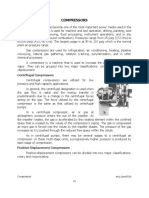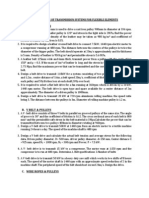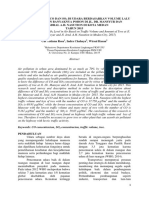39
39
Uploaded by
Edbert TulipasCopyright:
Available Formats
39
39
Uploaded by
Edbert TulipasOriginal Description:
Copyright
Available Formats
Share this document
Did you find this document useful?
Is this content inappropriate?
Copyright:
Available Formats
39
39
Uploaded by
Edbert TulipasCopyright:
Available Formats
8 Ü CHAPTER1
1.58 A gas at 40°C under a pressure of 21.868bar abs has a unit weight of 362 N/m. What is the value of R forthis
gas?What gas might this be?
| y =p/RT 362: (21.868 x 10)/[(R)(40 + 273)] R = 19.3m/K
This gas might be carbon dioxide. since its gas constant is 19.3 m/K (from Table A-6).
1.59 If water vapor (R = 85.7 ft/°R) in the atmosphere has a partial pressure of 0.60 psi: and the temperature is
80°F, what is its specificweight?
I y = p/RT = (0.60)(144)/[(85.7)(80 + 460)] = 0.00187Ib/n
Refer to Prob. 1.59. If the barometer reads 14.60 psia. ealculate the partial pressure of the air, its specific
weight, and the specific weight of the atmosphere (air plus water vapor).
I p.. = 14.60 0.60 = 14.00psia y =-p/RT
y", = ( l4.00)(144)/[(53.3)(80 + 460)] = 0.070011>/ft3 Y... = Yu:+ Traun»
7590») = 0.00187lb/ft (from Prob. 1.59) y,... = 0.0700 + 0.00187= 0.0719 lb/ft
1.61 (a) Calculate the density, specific weight, and specihc volume of oxygen at 20 °C and 40 kPa abs. (b) If the
oxygen is enclosed in a tigid container, what will be the pressure it the temperature is redumd to 1(Xl °C?
I (u) = (40)(1wO)/[(260)(20 + 273)] = 0.525 kg/m
p = leT
y = pg = (05100.31) = 5.15 N/m v, = 1/p = 1/0525 = 1.90 mlkg
(b) p- 1/V= p/RT. SinoeV and R are constants, V,/R= T/p= constant, (20 + 273)/40= ( 100 + 273)/p2
- 23.6 kPa.
p;
1.62 Helium at 149 kPa abs and 10 °C is isentropieally compressed to one fourth of its original volume. What is in
final pressure?
I p, v: =sz§ 149v:-°° - ((K/.,)...» p, -1488 kPa abs
(0) If 9 ft of an ideal gasat 75 °F and 22 psiais compressed
isothermallyto 2 11. what is the resultingpressure?
(b) What would the pressure and temperature have been if the process had been isenu'opic?
(.) P1V1-szz (200) - (P:)(Z) P2' 99Psi!
(b) in V1=sz; (22)(9)° = (p,)(2)'-=° p2= 155psia
" """"
7le. = (am)" Tz/(75+ 460) = (é)""° 1;= 840°R or 380°F
(a) 11 12 mJ of nitrogen at 30 °C and 125 kPa abs is permitted to expand isothermally to 30 In, what is the
resulting pressure?(b) What would the pressureand temperature have been if the process had been isentropic?
l (a) p. V.=P1Vz (125)(12)= (sz30) p2- 50-008 abs
(b) F. V. =PzVi (125)(12)""'= (P:)(30)"° P: = 34.705 858
13/1. = (,/p.) M 7,100 + 273) = (34.7/125)o " ° 7; = 210 K or 63 °C
If the viscosityof water at 68°F is 0.01008 poise. compute its absolute viscosity (/4) in pound-secondsper square
foot. lt the specihcgravity at 68 °F is 0.998. compute its kinematic viscosity(v) in square feel per second.
, The poiseis measuredin dyne secondsper squarecentimeter.Since1 lb = 444 300dynesand 1 ft - 30.48cm,
1|b-s/ft= 444000 dyne s/(30.48cm)= 478.8 poises
2.11x10 s1b_5m: z
=1.09x10 . ft/s
_ _M_
478.8
___ __._____
v=p vls=r (0.99.8)(624)
Convcn 15.14 poises to kinematic viscosityin square feet per second if the liquid has a spedhc gravity of 0.964.
I 11b--=s/ftz478.8 poise: (from Prob.1.65)
p - lS.14/478.8- 0.031621!)- 3/11z v - my - (0.03162)(32.2)/[(0.964)(62.4)]= 0.0169ftz/s
You might also like
- Module 6 Exercises Problem No. 3Document2 pagesModule 6 Exercises Problem No. 3Ariel GamboaNo ratings yet
- De Chavez - ECE135L - A38 - PLC #2Document2 pagesDe Chavez - ECE135L - A38 - PLC #2JohnNo ratings yet
- Me 313b Fluid Machineries Module Week 10 13 PDF FreeDocument60 pagesMe 313b Fluid Machineries Module Week 10 13 PDF FreeChris TopherNo ratings yet
- Thermo Solutions - Part14 PDFDocument1 pageThermo Solutions - Part14 PDFLiz ArfinNo ratings yet
- Fluid MechanicsDocument6 pagesFluid MechanicsLorde Wagayen100% (1)
- 1 1Document12 pages1 1Miguel Dominic BernardoNo ratings yet
- (x3) Problem 1 - 4 Industrial CompressorDocument13 pages(x3) Problem 1 - 4 Industrial CompressorLester Alfred M. OlasimanNo ratings yet
- Chapter 18Document4 pagesChapter 18Marco LuigiNo ratings yet
- 1 CompressorsDocument25 pages1 CompressorsCJ CerezoNo ratings yet
- Fluid Machinery Turbine Lecture 1Document22 pagesFluid Machinery Turbine Lecture 1Jarred TañedoNo ratings yet
- Ref Aircon 1a Reviewer by Hipolito Sta MariaDocument106 pagesRef Aircon 1a Reviewer by Hipolito Sta MariaMcKie Gaylon TolentinoNo ratings yet
- Ompad Ipe 02 Prob.8Document3 pagesOmpad Ipe 02 Prob.8Sam Ompad100% (1)
- MAGATDocument1 pageMAGATReden LopezNo ratings yet
- Experiment 2 HORSEPOWER EFFICIENCY GEAR RATIO AND SPEED RATIODocument10 pagesExperiment 2 HORSEPOWER EFFICIENCY GEAR RATIO AND SPEED RATIOJake Polo SantiagoNo ratings yet
- Module 6 Exercises Problem No. 4Document3 pagesModule 6 Exercises Problem No. 4Ariel GamboaNo ratings yet
- Thermodynamics 1 CompressDocument20 pagesThermodynamics 1 Compressjlss jp100% (1)
- Mikee EncodedDocument2 pagesMikee EncodedjaysonNo ratings yet
- Section 16 PDFDocument97 pagesSection 16 PDFherrerafaridNo ratings yet
- MD-1 BearingsDocument2 pagesMD-1 BearingsEleisa SilvaNo ratings yet
- eME4 HW3 Flores BSME-4BDocument6 pageseME4 HW3 Flores BSME-4Bjosh sanchezNo ratings yet
- ME REVIEW ThermodynamicsDocument65 pagesME REVIEW ThermodynamicsKhate ÜüNo ratings yet
- Section 16Document97 pagesSection 16Carolina FerrerNo ratings yet
- AIR CONDITIONING AND VENTILATION SYSTEM Prelim ExamDocument1 pageAIR CONDITIONING AND VENTILATION SYSTEM Prelim ExamJames Patrick TorresNo ratings yet
- صادق سالم محمد Practicle Cycle and its CalculationDocument18 pagesصادق سالم محمد Practicle Cycle and its Calculationعبدالمحسن علي ENo ratings yet
- Chapter 04Document5 pagesChapter 04stephen jamesNo ratings yet
- Sheldon - S File 3Document7 pagesSheldon - S File 3Prince Leonard R. VergaraNo ratings yet
- Diesel Power Plant Problem Solving Examination NAME: Vincent Rey Olario Y. Bsme - 5 Show Complete Solutions. Solve The Following: Problem 1Document5 pagesDiesel Power Plant Problem Solving Examination NAME: Vincent Rey Olario Y. Bsme - 5 Show Complete Solutions. Solve The Following: Problem 1BensoyNo ratings yet
- LiquidsDocument4 pagesLiquidsAldrin Esplana SardillaNo ratings yet
- From Table AT7 - Design of Machine Elements of Faires For AISI C1045 - S 96 Ksi - S 59 Ksi - E 30 x10 Psi A) Based On Ultimate StrengthDocument4 pagesFrom Table AT7 - Design of Machine Elements of Faires For AISI C1045 - S 96 Ksi - S 59 Ksi - E 30 x10 Psi A) Based On Ultimate StrengthMark AgusNo ratings yet
- IPE Practice QuestionsDocument49 pagesIPE Practice QuestionsLeslie Catindig100% (1)
- Feedwater Heater - Regeneration Analysis - HandbookDocument19 pagesFeedwater Heater - Regeneration Analysis - HandbookAnonymous wIPMQ5rhNo ratings yet
- 1.MEET 315LA MatScie Engineering ME Lab Module 1Document59 pages1.MEET 315LA MatScie Engineering ME Lab Module 1Cj TilamNo ratings yet
- Parato Ipe 02 Prob.08Document2 pagesParato Ipe 02 Prob.08Neal Christian Parato100% (1)
- The Development of Pedal Powered Water Pump As An Alternative For Crop Gasoline Powered Water PumpDocument3 pagesThe Development of Pedal Powered Water Pump As An Alternative For Crop Gasoline Powered Water PumpPerez Keith Jeswel N.No ratings yet
- Refrigeration-Systems Part 1Document11 pagesRefrigeration-Systems Part 1Sean GuanzonNo ratings yet
- Topic 7 Cascade Refrigeration SystemsDocument6 pagesTopic 7 Cascade Refrigeration SystemsJanelle D. Puti-anNo ratings yet
- Helical Spring ComputationDocument13 pagesHelical Spring ComputationEdmil Jhon AriquezNo ratings yet
- A. Flat Belt & Pulleys: Unit I Design of Transmission Systems For Flexible ElementsDocument3 pagesA. Flat Belt & Pulleys: Unit I Design of Transmission Systems For Flexible ElementsVijaya Prabhu KumarasamyNo ratings yet
- Emittance R Emittance R Config. Factor RDocument6 pagesEmittance R Emittance R Config. Factor RAJNo ratings yet
- RankineDocument12 pagesRankineMeej AustriaNo ratings yet
- Assignment No. 1 in PpeDocument3 pagesAssignment No. 1 in PpeJenny Mae PomedaNo ratings yet
- HVAC Assignment 1 Solutions (Updated)Document11 pagesHVAC Assignment 1 Solutions (Updated)Aleena Amin KhuwajaNo ratings yet
- 4 1Document10 pages4 1Miguel Dominic BernardoNo ratings yet
- Chapter 02Document14 pagesChapter 02stephen jamesNo ratings yet
- Refrigeration Problem 1-2 SolvedDocument4 pagesRefrigeration Problem 1-2 SolvedNorma FrancoNo ratings yet
- Final Exam Me155Document1 pageFinal Exam Me155Mr GreedyNo ratings yet
- Lecture 05 - Engine ParametersDocument33 pagesLecture 05 - Engine ParametersEkoms GamingNo ratings yet
- Gas Compressor ProblemsDocument2 pagesGas Compressor Problemskim dianon0% (1)
- Pineapple CutterDocument4 pagesPineapple CutterRIGOBERTO LOZANO MOLINANo ratings yet
- Air Quantities Sample Problems (Latent Heat and Cooling Load)Document8 pagesAir Quantities Sample Problems (Latent Heat and Cooling Load)Yan BerbosidadNo ratings yet
- Review Problems: Module 1 - CompressorsDocument5 pagesReview Problems: Module 1 - CompressorsJustine Somentac0% (1)
- Section 6Document232 pagesSection 6ahsanul haqueNo ratings yet
- Ans To The Report in Exp3Document3 pagesAns To The Report in Exp3dracarysNo ratings yet
- Clutches, Brakes and FlywheelsDocument23 pagesClutches, Brakes and FlywheelsNauman KhanNo ratings yet
- 1.0 Intro To Aircon (Properties of Moist Air) With Sample ProblemDocument10 pages1.0 Intro To Aircon (Properties of Moist Air) With Sample ProblemRenneil De PabloNo ratings yet
- Chapter 9-Hydroelectric Plant PDFDocument118 pagesChapter 9-Hydroelectric Plant PDFsindyNo ratings yet
- Module 5: Activity No. 2: P D D Q 150 GPM P PDocument4 pagesModule 5: Activity No. 2: P D D Q 150 GPM P PLeyzer MalumayNo ratings yet
- Vibration Engineering: Lesson 1 - Introduction To Vibration ControlDocument8 pagesVibration Engineering: Lesson 1 - Introduction To Vibration ControlAce Heart Rosendo AmanteNo ratings yet
- 478.8 2.11x10 1b 5m V P (0.99.8) (624) 1.09x10 Ft/sDocument1 page478.8 2.11x10 1b 5m V P (0.99.8) (624) 1.09x10 Ft/sEdbert TulipasNo ratings yet
- Madhya Pradesh Flying Club Ground School Summary of True StatementsDocument8 pagesMadhya Pradesh Flying Club Ground School Summary of True StatementsvidushiNo ratings yet
- De Cuong Tieng Anh 2012Document60 pagesDe Cuong Tieng Anh 2012Dao Xuan Phuong TrangNo ratings yet
- ChemistryDocument4 pagesChemistryMartin LayneNo ratings yet
- ID Perbedaan Kadar Co Dan So2 Di Udara Berdasarkan Volume Lalu Lintas Dan BanyaknyaDocument9 pagesID Perbedaan Kadar Co Dan So2 Di Udara Berdasarkan Volume Lalu Lintas Dan BanyaknyaelanNo ratings yet
- Teorias de La Personalidad - Duane P. AnDocument51 pagesTeorias de La Personalidad - Duane P. AnCarlos Andres ANo ratings yet
- 35.role of Elements in Sutainable BuildingDocument20 pages35.role of Elements in Sutainable BuildingmariyaNo ratings yet
- Unit 8 MeteorologyDocument12 pagesUnit 8 MeteorologyMaria Soledad Fernandez BortagarayNo ratings yet
- Met11 PDFDocument17 pagesMet11 PDFRaveena SharmaNo ratings yet
- Cigarette Smoking and Air PollutionDocument9 pagesCigarette Smoking and Air PollutionVivialyn YumulNo ratings yet
- DO - Luara - HW-3Document3 pagesDO - Luara - HW-3Nur AmaninaNo ratings yet
- Error EdmDocument22 pagesError EdmFaizan FathizanNo ratings yet
- Ozone Depletion - Chemistry ProjectDocument11 pagesOzone Depletion - Chemistry ProjectsujsamNo ratings yet
- Table 1. Average Temperature and Precipitation in BatangasDocument4 pagesTable 1. Average Temperature and Precipitation in BatangasGray JavierNo ratings yet
- Physics Give Reason Exam 18Document36 pagesPhysics Give Reason Exam 18apoorvnain15No ratings yet
- Hot and Dry Climate: Regions: West Rajasthan, Parts of Gujarat, S. Maharashtra, A.P. and KarnatakaDocument15 pagesHot and Dry Climate: Regions: West Rajasthan, Parts of Gujarat, S. Maharashtra, A.P. and KarnatakaShriram LeleNo ratings yet
- BSCS ModuleDocument41 pagesBSCS ModuleRanzel SerenioNo ratings yet
- The Hydrosphere PDFDocument23 pagesThe Hydrosphere PDFTabada NickyNo ratings yet
- Engine DerateDocument1 pageEngine DeratesancakemreNo ratings yet
- Daily Lesson Plan Energy ResourcesDocument14 pagesDaily Lesson Plan Energy ResourcesDarlen May DalidaNo ratings yet
- Surface Physiography: Altitudinal Zonation and RainshadowsDocument1 pageSurface Physiography: Altitudinal Zonation and Rainshadowsapi-19977019No ratings yet
- Science Book For Class 6 Maharashtra Board PDFDocument122 pagesScience Book For Class 6 Maharashtra Board PDFsandeepghiya585No ratings yet
- 31 - Telling The Relationship Expressed in The Selection Grade6Document12 pages31 - Telling The Relationship Expressed in The Selection Grade6Jen SottoNo ratings yet
- Earth Science Honors ReviewDocument26 pagesEarth Science Honors ReviewGreg SmithNo ratings yet
- Tuyển Tập Đề Ôn Tiếng Anh THPTQG 12Document71 pagesTuyển Tập Đề Ôn Tiếng Anh THPTQG 12Nguyễn Minh Ánh TrangNo ratings yet
- Sterhus, S., W.R. Turrell, S. J Nsson, andDocument207 pagesSterhus, S., W.R. Turrell, S. J Nsson, andkeith_pickeringNo ratings yet
- EST Micro ProjectDocument13 pagesEST Micro Projectmzaid sk100% (1)
- SF6 Gas PropertiesDocument6 pagesSF6 Gas PropertiesrmgsalemNo ratings yet
- Federal University Birnin Kebbi DSS 201Document7 pagesFederal University Birnin Kebbi DSS 201Nura MasterNo ratings yet
- 1 Basics: Cooling Tower Performance Basic Theory and PracticeDocument4 pages1 Basics: Cooling Tower Performance Basic Theory and Practicewaheed2286No ratings yet
- Student Log BookDocument13 pagesStudent Log Bookapi-237655094No ratings yet

























































































